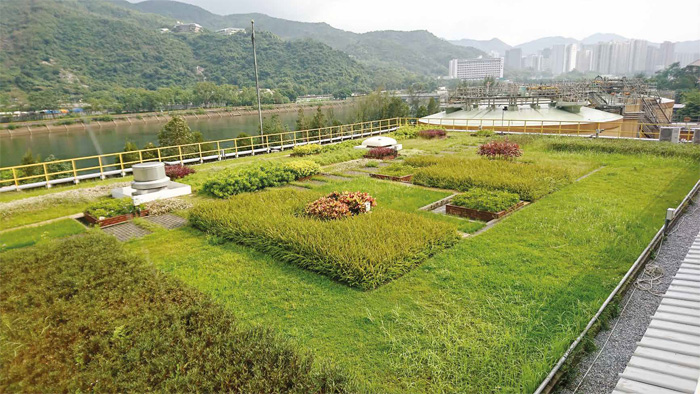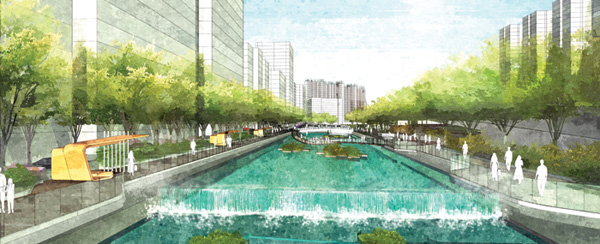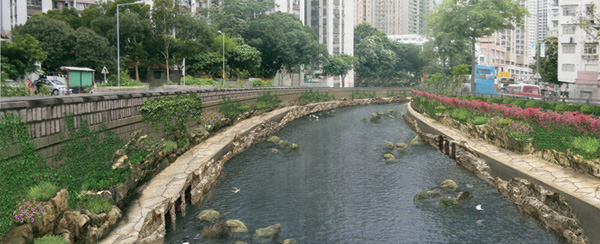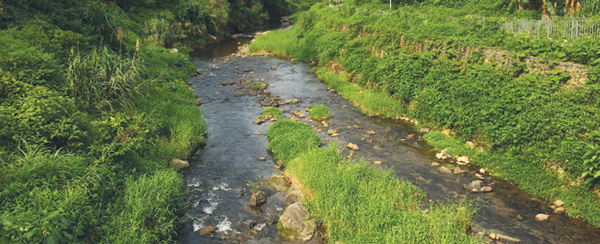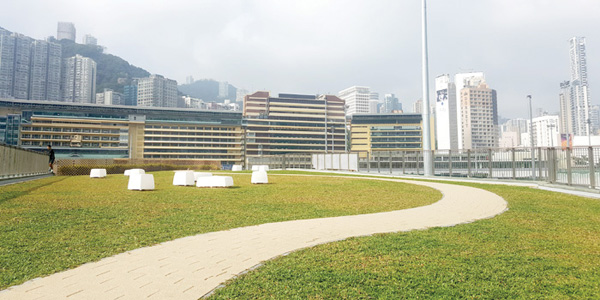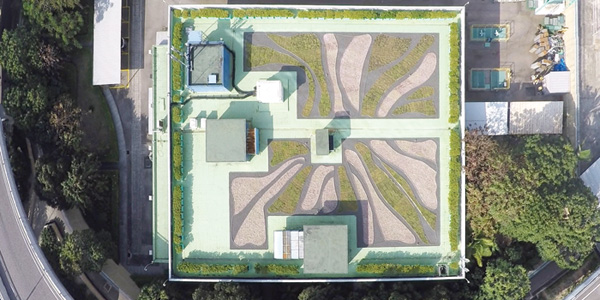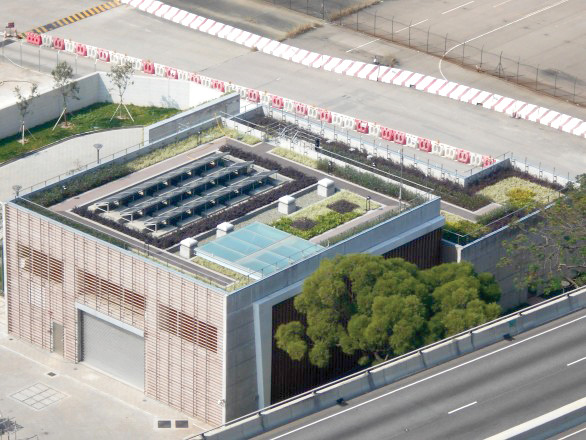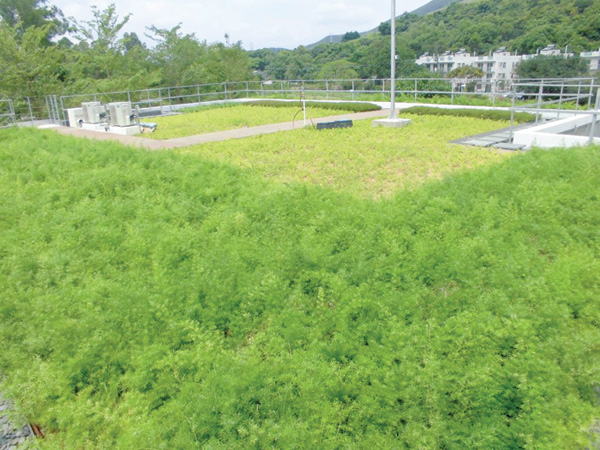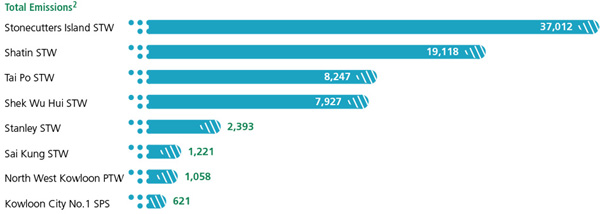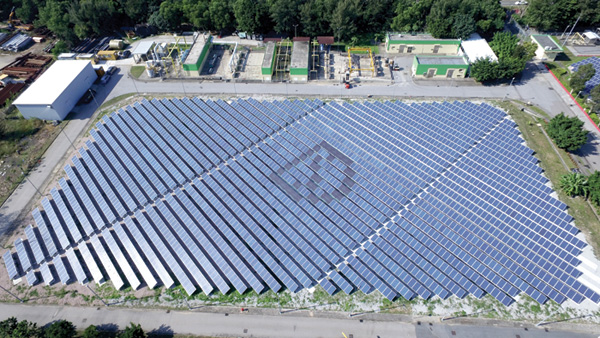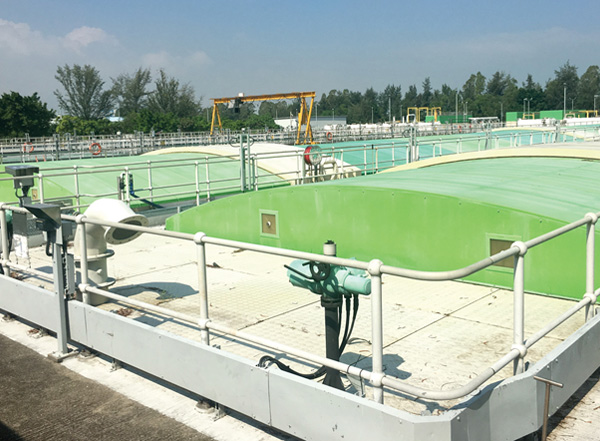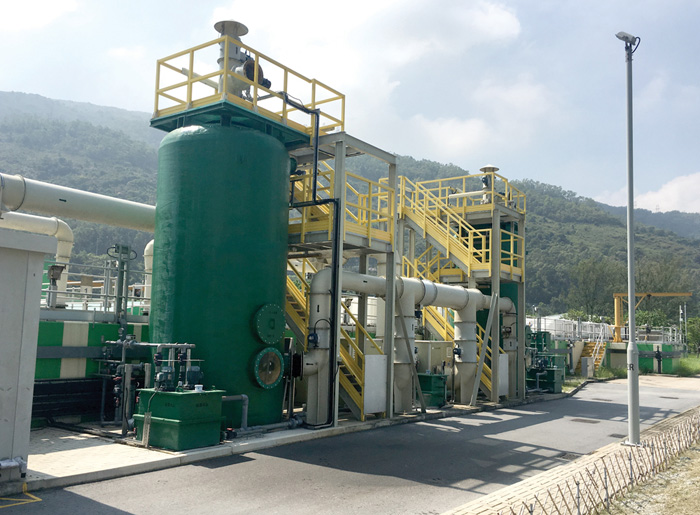Environmental Management
DSD has been incorporating sustainability elements into our facilities at all plants. With the implementation of “Blue-Green Infrastructure”, we actively promote green landscaping, energy conservation and emission reduction. We put environmental management a very high priority in each of our work projects in order to protect the environment and conserve water, etc.
Blue-Green Infrastructure 
DSD has been striving to implement the concept of revitalising water bodies by incorporating green and eco-conservation elements into channel and river training works. These include planting in river channels and along river banks, engineering natural stream settings, preserving river ecosystems, enhancing wildlife growth and introducing landscape designs, which not only beautify the environment, but also promote rivers and streams biodiversity.
Blue-Green Infrastructure
- Blue refers to rivers and water bodies; green refers to landscape greening.
- Building an urban drainage system that interweaves the natural environment with community characteristics and modern functions.
Revitalising Rivers and Nullahs
Revitalisation of Tsui Ping River
Kai Tak River Improvement Works
River Improvement Works in Upper Lam Tsuen
Roof Greening
Green design is also our priority consideration when constructing new plants. In 2016, the Kowloon Bay Sewage Interception Pumping Station was bestowed the highest Final Platinum Rating under BEAM Plus Assessment for New Buildings1, being DSD’s second infrastructure facility to obtain this award. Furthermore, the Shek Chung Au Sewage Pumping Station became DSD’s fourth infrastructure facility awarded with the Provisional Platinum Rating under BEAM Plus Assessment for New Buildings.
| 1 | BEAM Plus New Buildings is a comprehensive environmental assessment system for buildings recognised by the Hong Kong Green Building Council. |
|---|
Energy Management and Emission Control 
Sewage treatment is an energy intensive process. To save energy and reduce carbon emission arising from sewage treatment, DSD formed the Energy and Emission Management Team in 2007 to formulate and implement various energy saving measures and steer the application of renewable energy.
Carbon Audit
Carbon audit enables DSD to identify our plants’ major sources of emission and mitigate greenhouse gas emissions by reducing energy consumption, enhancing operation efficiency and using renewable energy, etc.
Carbon Footprint in 2015 (in tonnes of CO2 equivalent)
| 2 | Figures are rounded up and may not add up exactly to the total. |
|---|
Energy Saving Measures
In 2016-17, we continued to optimise the operation of the sewage treatment works and sewage pumping stations, while replacing ageing equipment with more energy efficient types in order to save energy. We saved about 1.54 million kilowatt-hours (kWh) of electricity (equivalent to carbon reduction of about 1,078 tonnes3).
| 3 | Using Hong Kong-wide default values of 0.7kg CO2 equivalent per kWh. |
|---|
Electric Vehicle
Powered by batteries, the operation of electric vehicles (EV) does not involve gasoline combustion or produce emission, which helps improve roadside air quality in Hong Kong. As at March 2017, there are 35 EVs in our fleet. In 2016-17, an additional of more than 10 medium EV chargers were installed in our sewage treatment works and sewer pumping stations in various district across Hong Kong making charging more convenient and readily available.
Renewable Energy
Installation of Photovoltaic Solar Panels in Sewage Treatment Facilities
We have deployed large-scale photovoltaic (PV) systems to supply electricity to our major facilities, including the Shatin STW, Sham Tseng STW, Yuen Long STW, Sai Kung STW, Shek Wu Hui STW, Sandy Bay PTW, Stonecutters Island STW and Siu Ho Wan STW. Estimated total generation capacity is 1,320 kilowatts (kW).
PV System at Siu Ho Wan STW
The largest PV system in Hong Kong was installed and commissioned at Siu Ho Wan STW during 2016-17. It is anticipated that the Solar Farm can generate as much as 1.1 million kilowatt - hours of electricity annually.
Turning Biogas to Energy
We installed a total of five CHP generators (with a combined capacity of 3.6 MW) at the Shatin STW, Tai Po STW and Shek Wu Hui STW. Gas-turbines (with a total capacity of 280kW) were also installed at Shatin STW and Yuen Long STW. The total equivalent electricity generated by biogas in our STWs achieved about 21 million kWh in 2016-17.
Climate Change Mitigation and Adaptation 
To address global challenges arising from climate change, we maintain close connection with other cities and regions. DSD is a member of Connecting Delta Cities, a subsidiary of the international organisation C40 Cities Climate Leadership Group, and represents the HKSAR Government to exchange views and experience on flood prevention with other delta cities. DSD is also a member of the Hong Kong/Guangdong Joint Liaison Group on Combating Climate Change. Representatives of the Guangdong Provincial Government visited DSD in 2016 to exchange proven experience in drainage system planning.
Water Resources Management 
DSD has incorporated concepts of sustainable water resources management into our newly constructed facilities to improve the utilisation rates of water resources. Major design elements include rainwater harvesting systems, underground stormwater storage systems, rain gardens and porous pavements, etc. Between 2012 and 2016, associated projects completed included the Kowloon City No. 1 and No. 2 Sewage Pumping Stations, Lai Chi Kok Drainage Tunnel, and Happy Valley Underground Stormwater Storage Scheme (HVUSSS).
In line with the Government's initiative to use reclaimed water under the Total Water Management Strategy, DSD continues to produce and use reclaimed water within its facilities while improving the operational reliability of its water reclamation facilities. In 2016-17, DSD generated reclaimed water at an average rate of approximately 1,300 cubic metres per day for non-potable purposes.
Odour Management 
Septic process of sewage will produce hydrogen sulphide which has a repulsive odour. To reduce the impact of DSD’s facilities on nearby residents, we have undertaken the following three odour control measures:
- Adding deodourising agents into sewage to suppress odour at its source;
- Covering facilities and components which are likely to emit odour; and
- Installing deodorising systems.
In addition, we regularly measure the levels of hydrogen sulphide in our plants to monitor the effectiveness of the odour control measures and to timely adjust the plant operations as necessary.
Green Office 
We make every effort to put the green office concept into practice at DSD headquarters. Green culture is introduced to every aspect of our day-to-day operation. Therefore, we have in place a series of green policies and measures to raise the environmental awareness of our staff.
In 2016-17, we recorded approximately 17% reduction in energy consumption compared with 2010-11, demonstrating DSD’s commitment to energy saving and consumption reduction. We have also been actively promoting “paperless meetings” by using electronic devices such as tablets and laptop computers for presentations and discussions in day-to-day meetings to reduce paper consumption.
- held 183 paperless meetings and circulated over 1,513 documents electronically
- Paper consumption was approximately 9,285 reams, down about 34% when compared with 2009-10



